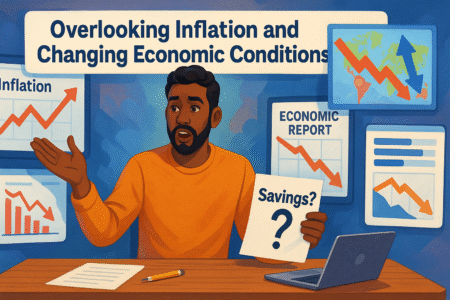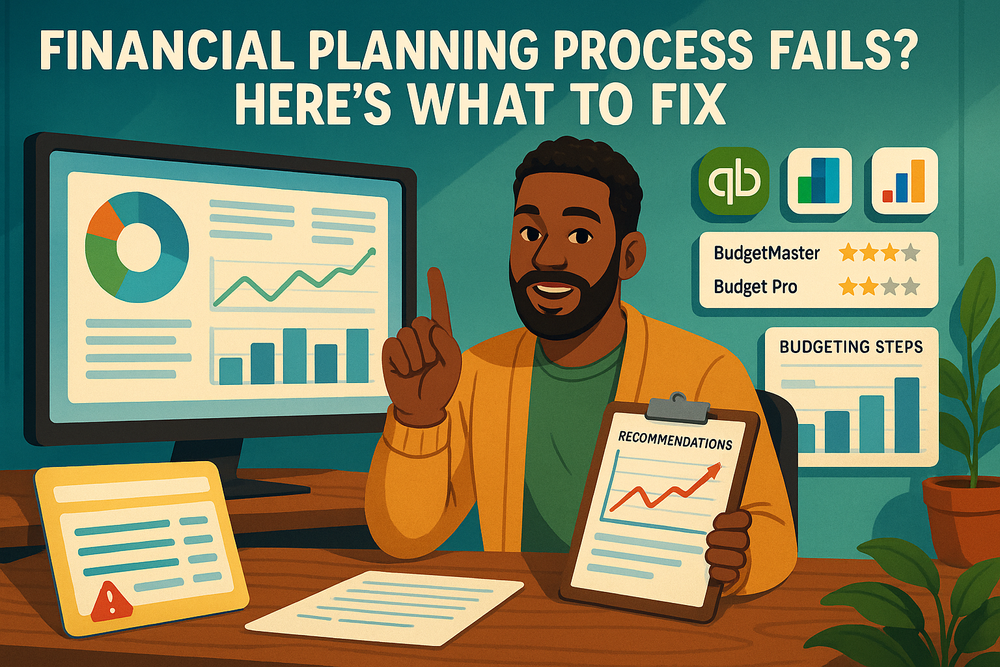Table of Contents
Is your financial planning process falling apart even though you’ve done everything “by the book”? You’re not alone. Many people set up a plan, follow common advice, and still find themselves missing targets, falling short on savings, or feeling uncertain about their financial future.
What’s really going wrong? Is it the lack of clear goals? Poor cash flow tracking? Maybe you’re relying on outdated data or ignoring economic shifts. This guide walks you through exactly what to fix so your financial planning process can finally work for you—not against you.
1. Ignoring Cash Flow Reality Wrecks the Foundation
Every great financial planning process begins with a firm grip on cash flow. When you don’t know where your money is going, you can’t make informed decisions about saving, investing, or spending.
Why Tracking Inflows and Outflows Is Non-Negotiable
Let me break it down for you—without tracking money coming in and going out, your budget is basically a guess. A lot of people assume they’re spending less than they earn, but when they finally check the numbers, the gap is tighter than they expected—or worse, in the red.
It’s not just about the big-ticket items like rent or a car payment. The small, daily habits—takeout, subscriptions, online deals—can quietly bleed your finances. Tracking gives you a clear picture of your financial behavior, not just what you hope it looks like.
In my experience, people often avoid tracking because it feels overwhelming. But once it’s in place, it’s one of the most empowering habits in the entire financial planning process.
How Poor Cash Flow Forecasting Derails Long-Term Goals
Imagine trying to plan a road trip without knowing how much gas is in the tank or how far you can go. That’s what poor forecasting does to your financial goals. You can’t plan for retirement, a house, or even next year’s vacation if your monthly numbers are unpredictable.
Cash flow forecasting helps you predict future income and expenses, so you’re not constantly reacting to shortfalls. It also makes it easier to see patterns—like when expenses spike during certain months—and to plan around them.
The absence of forecasting leads to impulsive decisions, missed savings targets, and delayed milestones. Long-term goals depend on short-term stability, and forecasting creates that bridge.
Tools That Help Visualize and Fix Cash Flow Gaps
You don’t have to do this manually anymore. Several tools make cash flow management much easier by offering visual dashboards and automatic tracking.
Here are a few I trust:
- You Need a Budget (YNAB): This is great for hands-on users who want a zero-based budget and real-time adjustments.
- PocketSmith: Ideal for forecasting—it lets you build what-if scenarios and see the impact months ahead.
- Monarch Money: A sleek, user-friendly option that syncs all accounts and offers intuitive spending reports.
These tools help you stay aware of not just where your money went, but where it’s likely to go next. They make it easier to adjust spending, spot leaks, and maintain financial momentum.
2. Setting Vague or Misaligned Financial Goals

Even the most diligent financial planning process can collapse if the goals are unclear or not aligned with your real-life values. Goals give your money direction—but only if they’re built the right way.
Why Generic Goals Undermine Financial Planning Success
Saying “I want to save more” isn’t a goal—it’s a wish. Generic statements like that don’t provide the motivation or clarity needed to follow through. Without clear purpose or metrics, it’s hard to measure progress or even know when you’ve succeeded.
This vagueness leads to scattered priorities. You might save a little, invest a little, spend a little—but none of it moves you meaningfully closer to what you actually want. That’s frustrating and often leads people to give up entirely.
Specificity gives you a target, and a target gives you momentum.
How to Link Financial Goals to Real-Life Milestones
Here’s a shift that works wonders: tie your goals to experiences and needs, not just numbers. Instead of aiming to “save $10,000,” aim to “build a 6-month emergency fund so I can leave a toxic job if needed.” That shift turns abstract goals into something personal and powerful.
When goals are rooted in real-life outcomes—like education, relocation, financial independence, or sabbaticals—they naturally feel more urgent and fulfilling. You’re not just working toward numbers; you’re working toward freedom, security, and opportunity.
This alignment helps you stick with your plan, especially when discipline is tested.
The Role of SMART Goals in Fixing Planning Gaps
SMART goals—Specific, Measurable, Achievable, Relevant, and Time-bound—aren’t just a corporate buzzword. They bring structure and accountability to your financial plan.
Let’s take an example:
- Instead of “I want to pay off debt,” try:
“I will pay off $3,000 of credit card debt in 6 months by cutting dining out to $100/month.”
Now you’ve got a clear dollar amount, a timeline, and a method. That’s something you can act on, measure, and track.
SMART goals also help you stay realistic. Setting a goal that’s too ambitious without a solid plan is a fast track to burnout and discouragement. When your goals are realistic and tied to specific actions, they become stepping stones—not stumbling blocks.
3. Underestimating Risk and Skipping Emergency Buffers
Too many people build their financial planning process around best-case scenarios. But life rarely follows a script—and if your plan can’t handle setbacks, it’s not really a plan.
How Ignoring Risk Scenarios Breaks Financial Stability
When you don’t account for potential risks—like job loss, medical emergencies, or market downturns—you create a fragile plan that can collapse under pressure. I’ve seen people stick to their budgets flawlessly, only to be thrown off by a single unexpected bill.
Ignoring risk isn’t just unrealistic; it’s dangerous. It forces you into reactive decisions that usually come with higher costs—like high-interest debt or dipping into retirement savings. Anticipating risks doesn’t mean expecting the worst, just being prepared for the unexpected.
Think of it like home insurance. You hope you’ll never need it, but you wouldn’t dare go without it.
Why an Emergency Fund Isn’t Optional in Planning
An emergency fund is your financial shock absorber. It gives you time and space to respond to challenges without derailing everything else you’ve worked for.
For most people, three to six months’ worth of essential expenses is a solid target. This isn’t about covering your whole lifestyle, just the must-haves—rent, food, insurance, and transportation.
Without this buffer, you’re forced to rely on credit cards, loans, or family support when life throws you a curveball. And while that might work once, it’s not a sustainable strategy. An emergency fund adds resilience to your financial planning process that no spreadsheet alone can deliver.
Risk Assessment Tools to Strengthen Your Safety Net
Here are a few tools that make it easier to evaluate and prepare for personal financial risks:
- Zogo: A financial literacy app that breaks down risk management basics into bite-sized lessons.
- Savology: Offers free financial planning assessments, including emergency fund readiness and risk coverage.
- Tiller Money: Helps you build custom spreadsheets that factor in risk and simulate financial what-if scenarios.
These tools aren’t just helpful—they’re eye-opening. They show you where you’re exposed and how to close those gaps before a crisis hits.
4. Relying on Outdated or Incomplete Financial Data
Even the best financial planning process can mislead you if it’s built on old or partial data. Accurate planning depends on up-to-date, complete information—and when that’s missing, it’s like trying to drive with a fogged-up windshield.
How Old Data Leads to Poor Financial Decisions
Outdated data makes your decisions stale. Maybe you’re planning based on income you no longer earn, or you’re assuming your expenses haven’t changed since last year. Either way, you’re flying blind.
A few small inaccuracies might not seem like a big deal, but they compound over time. Misjudging your cash flow or investment performance can easily throw off your entire plan. It’s especially risky when you’re trying to time big milestones like retirement, home buying, or starting a business.
You wouldn’t base your vacation plans on last year’s weather forecast—your financial plan deserves the same current, reliable information.
Fixing Data Gaps with Regular Reviews and Tools
Catching and fixing gaps in your data doesn’t have to be a big production. Small, regular check-ins can make a huge difference.
Here’s how you can start:
- Set a recurring calendar reminder every month to review your transactions and update account balances.
- Track any major changes—like raises, new expenses, or insurance updates—as they happen.
- Use spreadsheets or financial software to record everything in one place for easy access.
The key is consistency. Frequent reviews help you make course corrections early, not after things go off track.
Platforms That Automatically Sync and Update Financial Info
If you’re looking to simplify the process, there are great platforms that do most of the heavy lifting for you:
- Mint: Links to your bank accounts and credit cards to show real-time spending and balances.
- Empower (formerly Personal Capital): Ideal for tracking investments, net worth, and cash flow in one place.
- Quicken Simplifi: Designed for everyday money tracking with automatic updates and customizable reports.
These tools give you clarity without the manual effort. When your financial data is always current, your planning becomes more accurate, your decisions more confident, and your results more consistent.
5. Overlooking Inflation and Changing Economic Conditions

Inflation and economic shifts aren’t just headlines—they directly affect the real-world results of your financial planning process. Ignoring them can quietly sabotage even the most carefully crafted plan.
Why Ignoring Inflation Skews Long-Term Projections
If your plan assumes today’s prices will stay the same 10 years from now, you’re setting yourself up for a shortfall. Inflation slowly erodes the purchasing power of your savings and investments. What looks like enough money now may fall short in the future.
From groceries to housing to healthcare, prices change—and often unpredictably. If your projections don’t include inflation, you’re likely underestimating what you’ll need for retirement, education costs, or long-term care.
Even low inflation, over time, compounds into a major planning blind spot.
How to Integrate Economic Shifts into Your Planning Process
Economic conditions aren’t static, and your plan shouldn’t be either. Recession fears, interest rate changes, or a booming market—each shift creates ripples across your financial ecosystem.
Here’s how to adapt:
- Monitor interest rates, as they impact mortgage costs and bond returns.
- Watch employment trends and wages, especially if you’re planning income-based savings goals.
- Adjust your expectations for returns during volatile markets, especially in the short-term.
Keeping your plan flexible and responsive makes it far more durable, even in unpredictable environments.
Adjusting Financial Models for More Realistic Planning
Your financial models—spreadsheets, forecasts, and investment plans—should reflect reality, not ideal scenarios. A small tweak in inflation or market return assumptions can have a big impact on outcomes.
Tools like NewRetirement, RightCapital, and Personal Capital allow you to adjust variables like inflation and return rates to run different scenarios. This helps you see how your plan holds up under different conditions and encourages proactive, rather than reactive, decisions.
The more realistic your models, the more dependable your plan becomes.
6. Failing to Account for Tax Implications
Taxes aren’t just a once-a-year nuisance—they’re a constant force shaping your financial outcomes. A strong financial planning process considers taxes at every stage, not just in April.
How Taxes Quietly Undermine Your Financial Strategy
Taxes can eat away at income, investment gains, and withdrawals—often without you noticing until it’s too late. Ignoring tax impact can make a plan that looks solid on paper fall short in practice.
For example, pulling from a retirement account without considering the tax bracket you’re in can cost you thousands in unnecessary tax payments. Or investing in the wrong type of account can reduce your net returns year after year.
What you earn isn’t what you keep—and taxes are a big reason why.
Integrating Tax Planning into Every Financial Decision
Tax planning isn’t just for accountants. It should be baked into every decision you make—saving, investing, withdrawing, even giving.
Here are a few strategies that make a difference:
- Use tax-advantaged accounts like Roth IRAs, HSAs, and 401(k)s strategically.
- Time income and deductions, especially if you’re self-employed or receive irregular income.
- Consider the tax impact of selling assets, especially with capital gains.
Even small tax savings repeated consistently can turn into major long-term gains.
Key Tax Optimization Tools to Use Year-Round
You don’t need to figure this all out manually. There are several tools that help you optimize taxes throughout the year:
- Holistiplan: Designed for financial advisors but incredibly useful for scenario-based tax planning.
- TurboTax TaxCaster: Lets you estimate taxes ahead of time and test different decisions before making them.
- Keeper Tax: Ideal for freelancers—it tracks write-offs and keeps you audit-ready.
Using the right tools makes tax planning more about strategy than stress.
7. Not Reviewing and Adjusting the Plan Regularly
A financial planning process that stays static will eventually fail. Life evolves—and so should your plan. Regular reviews make sure your strategy keeps up with your reality.
Why Stagnant Plans Become Irrelevant Fast
Your income changes. Expenses shift. Family dynamics evolve. If your plan doesn’t keep pace, it quickly becomes outdated.
I’ve seen people stick to a plan made five years ago, only to realize it no longer fits their goals, lifestyle, or financial situation. It’s not about starting from scratch—it’s about keeping your plan alive and useful.
Think of it like a GPS. You wouldn’t use old directions when your route changes—you’d recheck the path.
Setting Triggers for Timely Financial Plan Reviews
Rather than waiting for problems to surface, you can set review triggers that prompt you to adjust ahead of time. Here are a few worth considering:
- Annual check-ins during tax season or at year-end.
- Major life changes like marriage, childbirth, or a job switch.
- Market events or income changes that could impact investments or savings.
These checkpoints help you stay proactive, not reactive.
Best Practices for Conducting Quarterly Plan Health Checks
A simple quarterly review doesn’t need to be complicated. Just ask yourself:
- Has my income or spending changed?
- Are my goals still the same—or have priorities shifted?
- Is my progress on track with where I expected to be?
Use tools like Tiller, YNAB, or a shared financial dashboard to keep everything in one place. And don’t hesitate to loop in a financial advisor if you’re unsure what adjustments are needed.
These small reviews keep your plan fresh and aligned with your life—not just your spreadsheets.
8. Ignoring Behavioral Biases in Decision Making

Even the most logical financial planning process can be derailed by human emotion. Understanding how biases shape our money decisions is the first step toward making smarter, more consistent choices.
How Emotions Sabotage Financial Planning
Fear, excitement, and even boredom can push people to act against their own best interests. I’ve seen folks pull investments at the worst possible time, overspend during stressful months, or put off saving because the future just feels too far away.
These aren’t character flaws—they’re natural emotional responses. But when emotions take over, the financial impact can last for years. Recognizing the emotional triggers behind your money habits can help you stay grounded when things get unpredictable.
Spotting Biases Like Overconfidence and Loss Aversion
Certain mental shortcuts can creep into your planning process without you even noticing:
- Overconfidence: Assuming your strategy is flawless or your investments are “safe” can make you overlook risks.
- Loss aversion: The fear of losing money often outweighs the excitement of gaining it, which can lead to overly cautious choices that stall growth.
- Anchoring: Sticking to an outdated idea—like the price you bought a stock for—can blind you to current realities.
Spotting these patterns early helps you pause, reflect, and make decisions based on facts instead of feelings.
Behavioral Tools and Tactics to Stay Rational and On Track
You can train your brain to make better financial decisions, even in stressful times. Here are a few tools that help:
- Morningstar’s Risk Tolerance Questionnaire: A detailed quiz that reveals your true risk appetite—not just what you think it is.
- Behavioral coaching platforms like Shaping Wealth: Designed to build emotional resilience around money.
- Journaling or documenting your financial decisions: This creates a track record you can reflect on, helping you spot patterns and improve over time.
By understanding your emotional tendencies, you make your financial planning process more human—and more effective.
9. Using One-Size-Fits-All Planning Templates
It’s tempting to grab a generic financial template and fill in the blanks, but real financial plans need to reflect your unique situation. Otherwise, you’re just following someone else’s roadmap.
Why Generic Plans Fail to Reflect Individual Realities
Cookie-cutter templates don’t know your income, your values, or your priorities. They assume your timeline, risk level, and goals match the average person’s—which rarely happens.
For example, a standard plan might recommend saving 15% of your income, but what if you’re trying to retire early? Or juggle student debt and caregiving at the same time? Generic advice often leaves key needs unmet.
Following a plan that doesn’t fit your reality usually leads to frustration or abandonment.
How to Personalize Your Financial Blueprint Effectively
A personalized plan starts with real clarity—what matters most to you, what trade-offs you’re willing to make, and how your lifestyle impacts your numbers.
Here’s how to tailor your plan:
- Prioritize goals based on your life stage and values.
- Factor in your career path, family responsibilities, and health needs.
- Adjust for irregular income if you’re self-employed or freelance.
You’re building more than just numbers—you’re designing a financial life that supports who you are.
Using Scenario Planning to Add Flexibility and Precision
Life changes fast, and a rigid plan won’t hold up. Scenario planning adds adaptability to your financial decisions.
Try this:
- Create at least three versions of your plan: conservative, base case, and optimistic.
- Use tools like RightCapital or eMoney Advisor to test how life events like a job change or housing move could affect your future.
- Revisit these scenarios every few months to keep your planning in sync with real life.
Scenario planning doesn’t predict the future—it prepares you for it.
10. Skipping Professional Guidance or Misusing It
A lot of people skip working with professionals either because they think it’s too expensive or because they’ve had a bad experience. But a good advisor can unlock insights and prevent mistakes you might not even see coming.
How DIY Planning Misses Critical Details
DIY tools are great, but they can only take you so far. Most people don’t have the time or expertise to stay on top of tax law changes, estate planning issues, or advanced investment strategies.
Missing even one detail—like failing to update beneficiaries or misunderstanding tax rules—can cost you years of progress. Even worse, you might not realize the mistake until it’s too late to fix.
Professional guidance isn’t about handing over control—it’s about gaining clarity.
Signs Your Financial Advisor Isn’t Adding Real Value
Not all advisors are created equal. If your current advisor is vague, product-pushy, or talks more than they listen, that’s a red flag.
Watch out for:
- One-size-fits-all recommendations.
- Lack of transparency on fees.
- No clear metrics for measuring your progress.
A good advisor acts more like a guide than a salesman—helping you navigate, not steering for you.
What a Qualified Planner Should Actually Help You Fix
Here’s what a truly helpful financial planner brings to the table:
- They help you align your plan with real-life goals and values.
- They spot blind spots and offer strategies you might not know about—like tax harvesting, charitable planning, or multi-generational wealth building.
- They partner with you long-term, reviewing your plan regularly and adapting it as your life evolves.
Look for someone who holds a fiduciary responsibility, explains things clearly, and focuses on what’s best for your whole financial picture—not just your portfolio.






